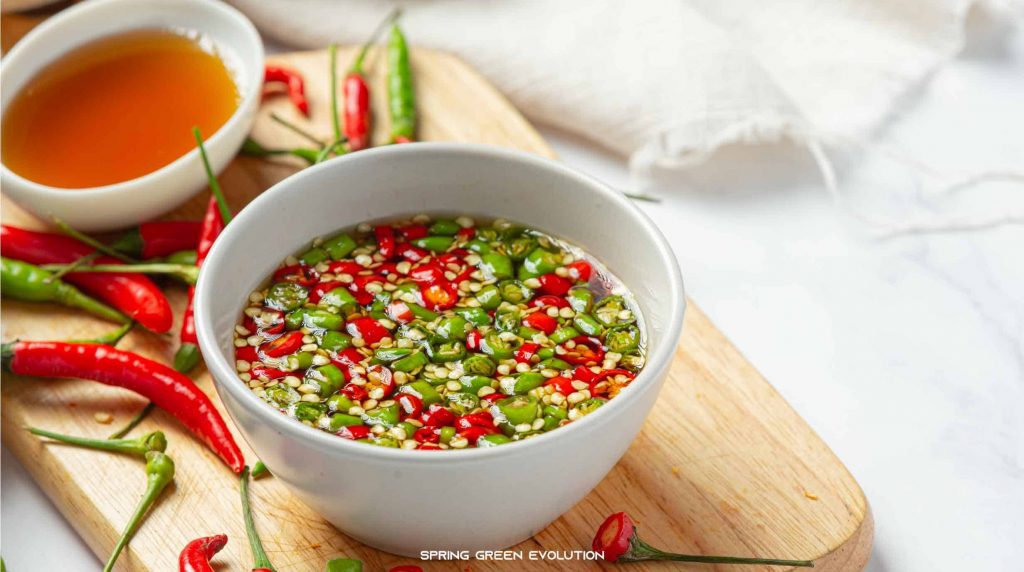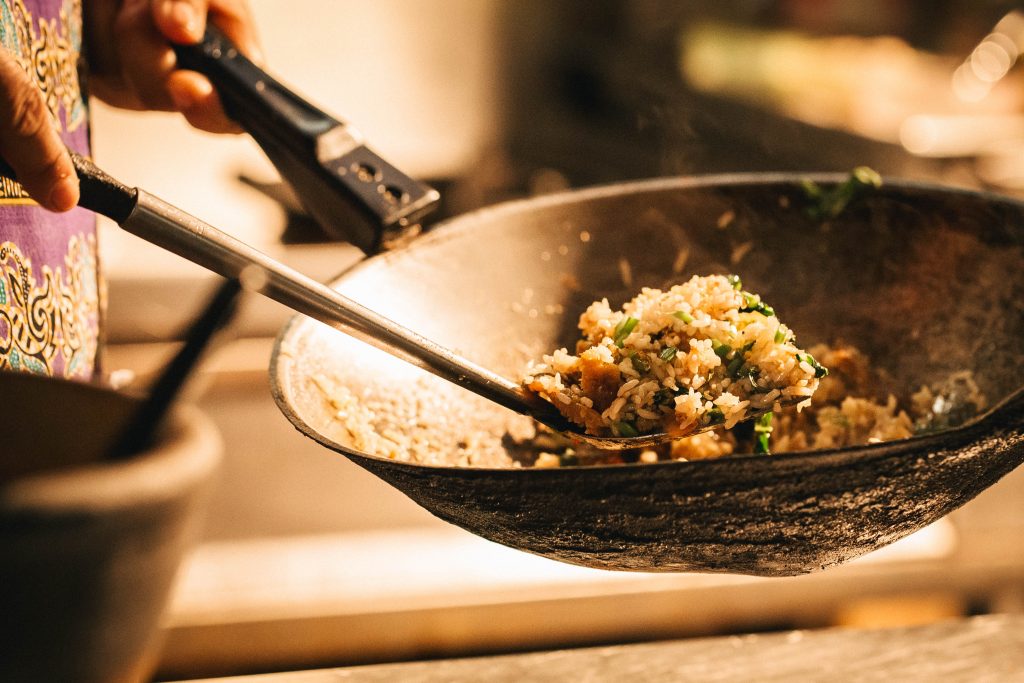Fish Sauce: A Classic Scent of Thai Cuisine

In a classic scene of almost every table in Southeast Asian restaurants, you will often find a flavorful condiment set served before you. And if you have ever traveled to Thailand, you might already be familiar with the four classic condiments, including sugar, vinegar and chilies, dried chili flakes, and the ultimately famous fish sauce, the key ingredient of many classic Thai dishes.
With its distinct smell, the fish sauce might not be a palatable food choice for everyone. However, this briny, funky, and savory fermented liquid is one of the most popular ingredients in East and Southeast Asian countries. And for Thailand, fish sauce is a national condiment that has long been in the dishes of every home with its versatile functions, whether used as an ingredient, seasoning, or even a dipping sauce in any rice-based or stir-fried dishes, soups, stews, or even curries.
About fish sauce
Fish sauce, or nam pla [น้ำปลา] in Thai, is a reddish, golden brown condiment made from small fishes such as anchovies or mackerels mixed with salt and fermented at an appropriate temperature. The number of ingredients used in making fish sauce, including the fermentation time and right temperature, all matter to its strong, aromatic scent and flavorful taste. Usually, the fish will be fermented for three months or up to two years. It is believed that to make the highest quality fish sauce, it should be long enough to turn the liquid into an amber, gold-colored.
Although there has been no confirmation whether fish sauce has originated in the West or the East, historians argue that the oldest record of the fish sauce production came from the coastline of the Black Sea in ancient Greek and Roman times. The Romans used the fish sauce as a condiment that can mix with various ingredients: pepper (garum piperatum), vinegar (oxygarum), wine (oenogarum), oil (oleagarum), or drinking water (hydrogarum). However, it became unpopular later on. Meanwhile, Silpa Watthanatham Magazine stated that fish sauce production has long been developed in the Southern China region over a thousand years ago, and it then has been passed through Vietnam, Cambodia, Thailand, and other Southeast Asian countries under various local names.
Thai Fish Sauce
Although fish sauce can be found worldwide, each culture’s rendition of the condiment tells a different story. In Thailand, the culture of fish fermentation has always been a quintessential identity of the riverside lifestyle of the people. Fermented fish comes in many form, including pla ra (salty fermented fish), pla som (tangy fermented fish), and tai pla (fermented fish gut), among others. The warm, sunny temperature and abundant resources are two significant factors that play a great role in the making of the highest quality fish sauce and its unique, flavorful taste with the perfect balance of the right level of saltiness as well as the characteristic aroma.
But did you know that the first drop of Thai fish sauce was produced about a century ago by a Chinese immigrant? Traditionally, each region of Thailand has its salty condiment to add a savory taste. For example, Northeastern cuisine uses pla ra, while the Southern part involves kapi (shrimp paste) in their cooking. Thai fish sauce was popularized by Laijiang Saetang (ไล่เจี้ยง แซ่ทั้ง), a Chinese immigrant who tried fermenting small fishes with salt in a clay jar, or a wooden barrel. This marked the beginning of the first fish sauce production in Thailand, and its popularization became a must-have item in every household. The first-ever fish sauce factory was then established in Chonburi, the eastern coastal region of the country.

Laijiang Saetang
(Photo Credit: Tiparos Fish Sauce)
Nowadays, fish sauce is one of Thailand’s most important export goods. According to the Department of Trade Negotiations, Thailand exported Thai condiments globally at the value of 949.11 million dollars last year, ranking first among ASEAN competitors and fourth in the global market. We also exported fish sauce at the value of 82 million dollars which accounts for 8.7 % of overall Thai condiment exports. This emphasizes the international recognition of our fish sauce.
But what is so magical about fish sauce and Thai food? The secret of Thai food goes to the balance of the taste in the dish. This is why fish sauce plays a critical role in personalizing the level of saltiness and creating the umami sensation in your savory experience. When used as a central ingredient in a dipping sauce, this funky condiment can create several amazingly delicious dipping sauces, such as nam pla wan (น้ำปลาหวาน), a salty but sweet dip that goes so well with any fruit. Isn’t it amazing that such a strong, pungent taste of the fish sauce, when mixed with other ingredients such as palm sugar, turns incredibly delicious with a perfect level of salty, spicy, sweet taste? Go dip it with crunchy fruits like green mangoes, and you will see why this menu is one of the favorites in the nation!
Besides that, you can also make nam jim jaew (น้ำจิ้มแจ่ว), a hot and sour dip that is a perfect sauce for Thai-style grilled chicken, and the ultimately famous prik nam pla (พริกน้ำปลา), or some might call it nam pla prik (น้ำปลาพริก), a dipping sauce made from the combination of sour, salty, sweet and spicy taste with chopped garlic and chilies. Not only that it tastes wonderful, but it’s also very easy to make with a few simple steps and it’s easier than you think! First thing first, you need to prepare the following ingredients:
- fish sauce
- lime juice
- Thai chilies
- garlic
- sugar

(Photo Credit: sgethai)
Once you’re prepared, chop the chilies and garlic into small pieces and put them together in a condiment bowl. You can see that these ingredients are a combination of all tastes you can personalize in your way. Let us say, if you want to make your sauce taste a little lighter, maybe not too spicy. You can use a few chilis and add more sugar to balance the hot taste. And now on to the next question, what should I eat it with? Yes, it goes with everything, but you can try it with simple meals like fried eggs, omelets, noodles, cooked-to-order food like crispy pork stir-fried with Chinese kale, pad kra pao (holy basil stir-fry with meat), or any savory dish. It’s almost as if prik nam pla is a part of any Thai dish rather than an only condiment that may or may not need.

(Photo Credit: DAY ONE)
How Its Made
The making of each fish sauce varies in different regions. Thai fish sauce is usually made from anchovies as they would bring the most flavorful taste to the savory liquid. Traditionally, before the mass production of fish sauce, this condiment was made from small fishes such as anchovy, mackerel, or freshwater minnow. These freshly cleaned fish will be layered with salt in a clay jar or cement pit and then covered with a mat, followed by a rock on top of it. It then will be left for the fermentation process for approximately one year before it will extract a savory sauce. The extraction will be boiled in hot water or bask in the sun’s heat until the liquid forms and becomes transparent. If there are still some fish left from the process, you can still make the fish sauce by fermenting those fish with salt water, but the quality of the fish sauce will be downgraded.

(Photo Credit: adaymagazine)
If you walk around any local Thai markets, you might see so many fishes on sale everywhere because it’s one of the most abundant foods that can be found. Sometimes, there are too many of them! This also happened years ago to a family of Chitti Pongpairoj (จิตติ พงศ์ไพโรจน์), CEO of Tiparos (ทิพรส), the first fish sauce manufacturer in Thailand. Back then, when his family was a fishmonger in a coastal city of Chonburi province, there were few times that small fish were left unsold as large-sized fishes were more of a popular choice of food for Thai people. They then took those fishes and fermented them with salt, making fish sauce. It is also a traditional way of preserving the fish from getting rotten or spoiled and eventually becoming a waste. It has become a knowledge that has been passed down from generation to generation that creates a rich taste in the cuisine of our culture, an essential condiment that Thai people cannot live without.
Thai Fish Sauce, Thai Spirit
The prevalence of fish sauce in Thai cooking reflects the Thai people’s mastery in using strong ingredients. Thai food is famous for its layering to scents and flavors. Through trial and error, Thai cooks have managed to find a way to bring out the umami quality of the fish sauce. This adds a much-welcomed spruce to many of today’s most well-known Thai dishes. Even now, techniques and skills in using fish sauce are being passed and experimented with, creating new dishes that are sure to excite the palette.
The origin of Thai fish sauce also reflects the Thai people’s value of openness. Thai people have welcomed Chinese immigrants into their society and even adopted ingredients made by these immigrants into their kitchen. Through this openness, fish sauce has made its way to every Thai dinner table (and heart).

(Photo Credit: cheezelooker )
Don’t miss out!
The fish sauce might smell pungent and funky, but don’t be afraid; just try flavoring it as a seasoning during your stir-fried cooking. It will give off an aromatic scent later. Think of it as a flavor enhancement to add on a level of saltiness and umami flavor, just a few drops, and see if it is perfect for you! Trust me, Thai fish sauce goes well not only with Thai but also with any cuisine!
Sources
- http://magazine.culture.go.th/2015/4/mobile/index.html#p=61
- https://voicetv.co.th/read/rymiBo6im
- https://mgronline.com/science/detail/9510000004398
- https://www.blockdit.com/posts/5cfe439fb7d4375bf7ee7227
- https://www.worldhistory.org/article/1276/fish-sauce-in-the-ancient-world/#:~:text=Broadly%20speaking%2C%20Roman%20fish%20sauces,for%20varying%20amounts%20of%20tim
- https://www.worldhistory.org/article/1276/fish-sauce-in-the-ancient-world/#:~:text=Broadly%20speaking%2C%20Roman%20fish%20sauces,for%20varying%20amounts%20of%20time
- https://www.dtn.go.th/th/
- https://www.dtn.go.th/th/tradeinfo/620c73aeef4140079855e24d?cate=5e9e9209ef4140e1c21ec9c7
_______________________________________________________________________________
Author: Pattanun Arunpreechawat
5 September 2022


